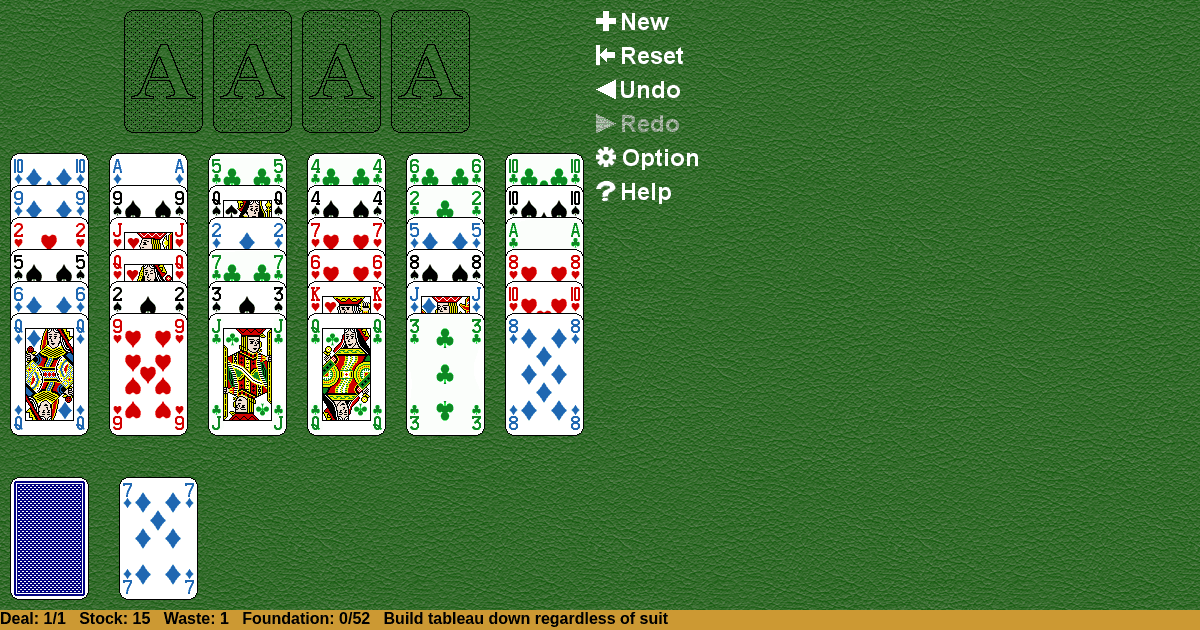Thirty Six
Home |
How to play |
FAQ |
About
How to play Thirty Six?
Game Objective:
The primary goal in Thirty Six Solitaire is to move all cards from the tableau and any remaining deck into the four foundation piles, building each foundation up in suit from Ace to King.
Setup & Layout:
- Deck Used: Standard 52-card deck.
- Tableau: Deal 36 cards into six tableau piles, each containing six cards. All cards in the tableau are dealt face up and should be splayed (fanned) downward so that every card is visible.
- Foundations: Four foundation piles, one for each suit, start empty.
- Stock: The remaining 16 cards form the stock (also called the hand), which is kept aside face down.
- Discard/Waste Pile: Some rule sets use a discard pile, where cards from the stock are dealt. In other versions, new cards from the stock are dealt directly onto the tableau (see Special Rules & Edge Cases).
- Key Play Areas:
- Tableau: The main area where cards are built down and moved.
- Foundations: The target area for building up each suit.
- Stock: The reserve of undealt cards.
- Discard/Waste: Where cards from the stock may be placed, depending on the variant.
Thirty Six Solitaire Rules:
- Tableau Building:
- Cards are built down by rank (e.g., 7 on 8), ignoring suit and color.
- In some variants, sequences can be moved regardless of suit. Other variants may require sequences to be of the same suit.
- Moving Cards:
- Single cards or sequences in correct descending order can be moved as a unit between tableau piles.
- Any card or sequence may be moved to an empty tableau pile.
- Foundations:
- Foundations are built up by suit from Ace to King (A-2-3-…-K).
- Only cards of the same suit may be placed on a foundation.
- Stock/Discard:
- When no more moves are available or at the player's discretion, deal one card from the stock onto the discard pile or directly onto a tableau pile, depending on the variant.
- The top card of the discard pile is always available for play to the tableau or foundations.
- No Redeal: Once the stock is exhausted, no further cards are dealt.
Gameplay:
- Initial Moves:
- Examine the tableau for possible moves, building cards down by rank, regardless of suit or color.
- Move Aces to the foundations as soon as they become available.
- Moving Sequences:
- Move any legal single card or descending sequence to another tableau pile or to an empty tableau space.
- Move cards to the foundations in ascending order by suit.
- Dealing from Stock:
- When no further moves are possible or at any time, deal one card from the stock to the discard pile (or, in some variants, directly onto the first tableau pile).
- The top card of the discard pile is now available for play.
- Filling Empty Tableau Piles:
- Any card or legal sequence may be moved to fill an empty tableau pile.
- Continue Play:
- Alternate between making moves within the tableau, moving cards to the foundations, and dealing from the stock until all cards are in the foundations or no moves remain.
Winning & Losing Conditions:
- Winning Condition: The game is won when all 52 cards have been moved to the foundation piles, each built up in suit from Ace to King.
- Losing Condition: The game is lost if no legal moves remain and the stock is exhausted, with cards still left in the tableau or discard pile.
Special Rules & Edge Cases:
- Empty Tableau Piles: Any card or sequence (in descending order) can be moved to an empty tableau pile.
- Moving Sequences: Most sources allow moving sequences regardless of suit, but some variants require all cards in a sequence to be of the same suit. Confirm the rule set you are using.
- Dealing from Stock: Some variants deal new cards from the stock to a discard pile, while others deal directly onto the first tableau pile. The discard pile's top card is always available for play.
- No Redeal: There is no redeal; once the stock is empty, the game continues only with available moves in the tableau and discard pile.
- Aces During Deal: In some versions, Aces that appear during the initial deal are immediately moved to the foundations.
- Partial Builds: Partial sequences in correct order may be moved together, not just single cards.
- No Suit or Color Restriction in Tableau: Building down in the tableau ignores suit and color, unless playing a variant that requires same-suit sequences.
This guide reflects the most commonly accepted and referenced rules for Thirty Six Solitaire, prioritizing official and consensus sources. Variations exist; always confirm the specific rules in use for your version.

Solitaire Collection
About Thirty Six
Rate (Thirty Six)
4.7 / 5
1,916 votes



























































